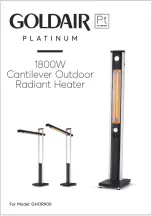
56
CHECKING THE FIRING RATE
Follow these instructions to determine the actual firing rate of the
water heater:
Note:
The heaters covered by this manual are capable of
modulating their firing rate. The firing rate should be
checked with the heater operating at it's full firing rate.
1.
Ensure there are no other gas fired appliances connected to
the gas meter firing during this test.
2.
Contact the gas supplier to determine the heating value, in Btu
per cubic foot, of the gas supply.
3. Connect a manometer to the supply gas pressure tap. Follow
.
4.
Start the water heater and ensure it is firing.
5.
Check the supply gas pressure, refer to
for
correct pressure.
6. Locate the gas meter serving the water heater.
7.
Time how long (in seconds) it takes for one cubic foot of gas
to be used while the water heater is firing with a stop watch.
8.
Use the formula below to “clock” the gas meter and determine
the actual firing rate of the water heater based on the heating
value (Btu per cubic foot) of the gas supply:
x H = Btu/hr
3600
T
x 1050 = 300,000 Btu/hr (87.9 kW)
3600
12.6
Example:
3600 = seconds in one hour.
T = time, in seconds, to burn one cubic foot of gas.
H = heating value of gas in Btu per cubic foot.
Btu/hr = actual firing rate of the water heater.
Note:
1050 Btu per cubic foot is a standard value for natural
gas. Standard propane gas Btu content is 2500 Btu
per cubic foot. Btu values may change in certain
areas and at high elevations. Check with the local gas
utility company.
TO TURN OFF GAS SUPPLY
1.
Change the Operating Set Point to the lowest temperature
setting, see
Operating Set Point and Differential Adjustment
2.
When the water heater has completed its shut down sequence
and enters the standby mode, turn the water heater’s Enable/
Disable switch to the “Disable” position. When in the "Disable"
position the switch only removes electrical power from the gas
valve so that water heating is disabled. The display, CCB, and
other electrical components will still be energized and the display
will read "Water Heating Disabled".
3. Close Main Gas Shutoff Valve, see
HIGH ALTITUDE INSTALLATIONS
Fire and Explosion Hazard
Gas and carbon monoxide detectors are
available.
Overfiring could result in fire or
explosion.
Under no circumstances should the
input exceed the rate shown on the
water heater’s rating label.
Breathing Hazard - Carbon Monoxide Gas
Breathing carbon monoxide can cause brain damage or
death. Always read and understand instruction manual.
Under no circumstances should
the input exceed the rate shown
on the water heater’s rating label.
Overfiring could result in damage to
the water heater and sooting.
Gas and carbon monoxide detectors
are available.
The water heaters covered by this manual are certified for use
without modification for altitudes up to 10,100 feet (3,078 m).
Most gas utility companies de-rate their gas for high altitudes,
making it unnecessary to install high altitude orifices.
Note:
The actual firing rate of the water heater must not
exceed the input rating on the water heater's rating
label under any circumstances.
Note:
Due to the input rating reduction at high altitudes,
the output rating of the water heater is also reduced
and should be compensated for in the sizing of the
equipment.
Содержание SUF 60120 THRU
Страница 67: ...67 WIRING DIAGRAM Figure 67 Wiring Diagram...
Страница 77: ...77 NOTES...
Страница 78: ...78 NOTES...
Страница 79: ...79 NOTES...
















































